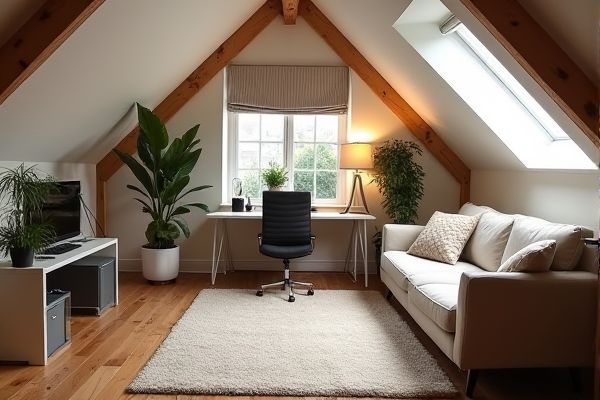
An attic office offers a quiet, focused workspace designed for productivity, while an attic studio provides a creative environment ideal for art, music, or design projects. Discover which option best suits Your needs by reading the rest of the article.
Table of Comparison
| Feature | Attic Office | Attic Studio |
|---|---|---|
| Purpose | Workspace for administrative or computer tasks | Creative space for art, music, or design |
| Layout | Structured desks, ergonomic chairs, storage | Open area with flexible setup for equipment and materials |
| Lighting | Bright task lighting, natural light optimized | Adjustable lighting for creative ambiance |
| Acoustics | Minimal noise, soundproofing optional | Soundproofed for recording or noise control |
| Equipment | Computers, office supplies, printers | Art supplies, musical instruments, recording gear |
| Storage | Organized filing and document storage | Material storage adapted to creative tools |
| Space Utilization | Maximizes productivity and organization | Maximizes flexibility and creative freedom |
| Insulation | Standard for comfort during work hours | Enhanced for sound and temperature control |
Understanding the Difference: Attic Office vs Attic Studio
An attic office is designed primarily for productivity, featuring ergonomic furniture, organized storage, and technology setups ideal for focused work tasks. An attic studio, meanwhile, emphasizes creative activities like art, music, or photography, offering open space, natural light, and customizable layouts to inspire imagination. Understanding this difference helps you choose the right attic space that aligns with your professional needs or artistic passions.
Purpose and Functionality
An attic office is designed primarily for productivity, featuring ergonomic furniture, ample lighting, and organized storage to create a focused work environment. An attic studio emphasizes creativity and versatility, often equipped with art supplies, musical instruments, or photography gear to support various artistic projects. The functionality of an attic office centers on efficiency and minimal distractions, while an attic studio prioritizes inspiration and flexible space arrangements.
Space Utilization and Layout
An attic office typically maximizes space with functional furniture like desks, shelves, and ergonomic seating arranged to enhance productivity within limited square footage. An attic studio emphasizes open layouts and flexible zones to accommodate creative activities such as art, music, or photography, often incorporating natural light and storage for materials. Efficient space utilization in an attic office prioritizes organization and workflow, while an attic studio focuses on adaptability and inspiration.
Lighting Considerations
Attic offices require ample task lighting and adjustable fixtures to reduce eye strain during focused work, often incorporating a combination of natural light from skylights and adjustable LED lamps. Attic studios demand versatile lighting solutions that enhance color accuracy for creative projects, including diffused natural light sources and adjustable daylight LED bulbs to simulate true color conditions. Proper insulation and window treatments are essential in both spaces to control glare and maintain consistent lighting throughout the day.
Storage Solutions and Organization
An attic office typically features built-in shelves, filing cabinets, and desk organizers designed to keep documents and office supplies neatly arranged, optimizing your workspace for productivity. In comparison, an attic studio emphasizes open storage solutions such as modular racks and display walls to accommodate art materials, tools, and creative projects, promoting easy access and inspiration. Choosing between the two depends on your need for structured organization versus flexible, accessible storage tailored to your work style.
Design and Aesthetic Choices
An attic office prioritizes functionality with ergonomic furniture, ample storage solutions, and focused lighting to create a productive workspace, often featuring minimalist and professional design elements. In contrast, an attic studio embraces creativity with open layouts, flexible workstations, and abundant natural light, using vibrant colors, artistic decor, and inspirational materials to foster imagination. Both spaces optimize the unique angles and natural character of the attic, but an office emphasizes efficiency while a studio highlights artistic expression and comfort.
Comfort and Productivity Factors
An attic office is designed primarily for focused work, featuring ergonomic furniture, soundproofing, and efficient lighting to enhance comfort and productivity. An attic studio emphasizes creative activities, requiring flexible space arrangements, natural light, and ventilation to foster inspiration and sustained work periods. Both spaces benefit from insulation and temperature control, but the office prioritizes minimal distractions while the studio encourages an open, stimulating environment.
Soundproofing and Privacy Needs
An attic office typically requires enhanced soundproofing to minimize distractions during work calls and maintain confidentiality, utilizing materials like acoustic panels and insulated drywall. In contrast, an attic studio demands superior soundproofing to control external noise for clear recording or creative work, often incorporating double-glazed windows and specialized sound-absorbing foam. Privacy needs differ as an office prioritizes a quiet, isolated environment for productivity, while a studio emphasizes acoustic isolation to prevent sound leakage during artistic projects.
Essential Tools and Furnishings
An attic office requires ergonomic furniture such as a quality desk, adjustable chair, and sufficient lighting to support productivity and comfort during work hours. Your attic studio, on the other hand, demands creative tools like easels, drafting tables, storage for art supplies, and versatile lighting to accommodate artistic projects. Both spaces benefit from smart storage solutions and climate control to ensure functionality and comfort.
Choosing the Right Setup for Your Needs
An attic office offers a quiet, organized workspace optimized for productivity and storage, whereas an attic studio provides a creative, flexible area tailored for artistic projects and equipment. Your choice depends on whether you prioritize functional work efficiency or an inspiring environment for creativity. Evaluate the available space, lighting, and ventilation to ensure the setup aligns perfectly with your daily activities and comfort.
 homyna.com
homyna.com